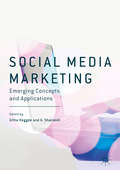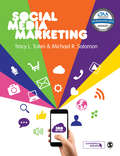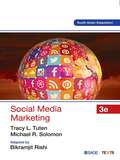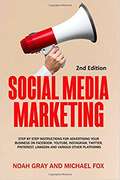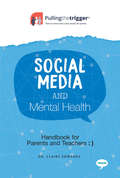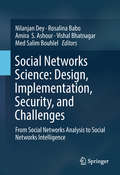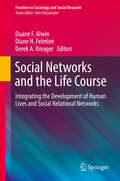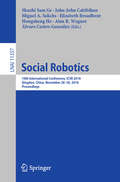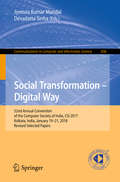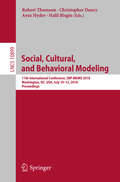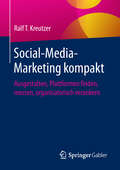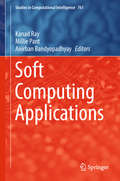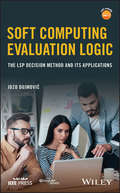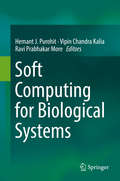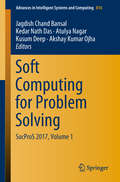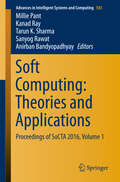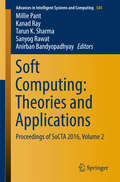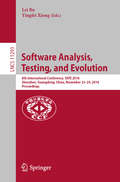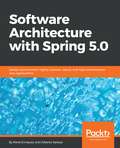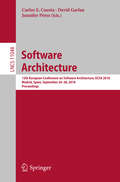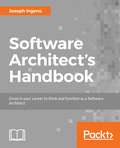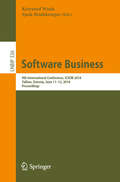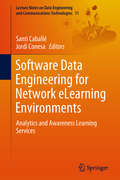- Table View
- List View
Social Media Marketing
by Githa Heggde G. ShaineshThis book focuses on the role of social media as the next major game-changer. Social media has emerged as the defining trend in the last decade and continues to restructure communication and interactions between individuals, communities, governments and businesses. Researchers and marketers are still struggling with the profound impact of rapidly evolving social media on viral user-generated content, its ability to shape consumer perceptions, and the constantly changing landscape for developing business cases to proactively engage with stakeholders. The growing opportunities to “hear” about customer priorities and concerns on company managed channels as well as third-party review sites, including social media pages, across the digital space are accompanied by the challenges of responding to these conversations in real-time, which calls for a massive shift in the way marketing functions engage in dialogue with customers. As leading users of social media in emerging markets, Indians are increasingly logging into their Facebook and Twitter accounts, with the country recording the highest growth in social networking. This book begins by discussing the impact of social media on marketing, from brand building, communications, and advertising to customization and customer engagement. The book approaches the subject matter systematically, identifying broad trends, concepts and frameworks in the first few chapters. It then goes on to address the varied application of social media in marketing for different sectors. Primarily focusing on understanding digital consumers, the book integrates social media with marketing and the outcome. It also presents new, selected cases of successful digital companies in emerging markets never before considered. Researchers and managers alike will find this book to be a handy reference guide to social media in emerging markets.
Social Media Marketing
by Dr Tracy L. Tuten Professor Michael R. SolomonThis book is not available as an inspection copy. For more information contact your local sales representative. **Winner of the TAA 2017 Textbook Excellence Award** “Social Media Marketing deserves special kudos for its courage in tackling the new frontier of social media marketing. This textbook challenges its readers to grapple with the daunting task of understanding rapidly evolving social media and its users.” TAA Judges Panel Social Media Marketing was the first textbook to cover this vital subject and has quickly become the market leader. It melds essential theory with practical application and covers core skills such as strategic planning for social media applications, incorporating these platforms into the brand’s marketing communications, and harnessing social media data to yield consumer insights. The authors outline the ‘four zones’ of social media that marketers can use to help achieve their strategic objectives: 1. Community 2. Publishing 3. Entertainment 4. Commerce The new third edition has been extensively updated to include new content on tactical planning and execution and coverage of the latest research within social media marketing. Expanded new case studies and examples including Facebook, Instagram, Twitter and Snapchat are discussed in relation to globally recognized brands such as Pokemon Go, Nike, Amazon Kindle and Lady Gaga. The book is complemented by a companion website that offers valuable additional resources for both instructors and students, including author videos discussing key social media marketing ideas and concepts, author-selected YouTube video playlists, additional case studies, further weblinks, PowerPoint slides and Testbank. Suitable for modules and courses on social media marketing.
Social Media Marketing
by Dr Tracy L. Tuten Professor Michael R. SolomonThis book is not available as an inspection copy. For more information contact your local sales representative. **Winner of the TAA 2017 Textbook Excellence Award** “Social Media Marketing deserves special kudos for its courage in tackling the new frontier of social media marketing. This textbook challenges its readers to grapple with the daunting task of understanding rapidly evolving social media and its users.” TAA Judges Panel Social Media Marketing was the first textbook to cover this vital subject and has quickly become the market leader. It melds essential theory with practical application and covers core skills such as strategic planning for social media applications, incorporating these platforms into the brand’s marketing communications, and harnessing social media data to yield consumer insights. The authors outline the ‘four zones’ of social media that marketers can use to help achieve their strategic objectives: 1. Community 2. Publishing 3. Entertainment 4. Commerce The new third edition has been extensively updated to include new content on tactical planning and execution and coverage of the latest research within social media marketing. Expanded new case studies and examples including Facebook, Instagram, Twitter and Snapchat are discussed in relation to globally recognized brands such as Pokemon Go, Nike, Amazon Kindle and Lady Gaga. The book is complemented by a companion website that offers valuable additional resources for both instructors and students, including author videos discussing key social media marketing ideas and concepts, author-selected YouTube video playlists, additional case studies, further weblinks, PowerPoint slides and Testbank. Suitable for modules and courses on social media marketing.
Social Media Marketing
by Michael R. Solomon Tracy L. TutenStudents of MBA and PGDM courses would be the primary target audience for this textbook. It will also be useful to attendees of Executive and Management Development Programs. Social Media Marketing blends essential theory with practical application and covers core skills such as strategic planning for social media applications, incorporating these platforms into the brand's marketing communications, and harnessing social media data to yield consumer insights. This textbook outlines the "four zones" of social media - community, publishing, entertainment, and commerce - which marketers can use as a part of the strategic planning processes to achieve their core objectives. The new edition has been extensively updated and expanded to include a new chapter on tactical planning and execution, and covers the latest research within social media marketing. It also incorporates new case studies and examples, including Facebook, Instagram, Twitter, and Snapchat; and discusses these in relation to globally recognized brands. This adaptation integrates India-specific examples, cases, and data to make the content suitable for the students of South Asia. Key Features: • Comprehensive, strategic, well-organized, and result-oriented coverage of social media • Integrates latest examples and research data from India and the rest of the world in a reader-friendly layout • New case studies on Indian brands - Patanjali, Saffola, Durex, and Uber (India) • Robust companion website offering additional case studies, instructor resources, test bank, and suggested video links
Social Media Marketing: Step by Step Instructions for Advertising Your Business on Facebook, Youtube, Instagram, Twitter, Pinterest, Linkedin and Various Other Platforms (Second Edition)
by Noah GrayThis book covers a lot of Social Media Platforms: Facebook, Facebook Advertising, Youtube, Instagram, Twitter, Pinterest, Linkedin, Snapchat, Reddit, Tumblr, Quora, Goodreads, Periscope, Flickr, Google Adwords, Google+. If you are ready to improve your business through social media marketing, this book will provide you with everything you need.
Social Media and Mental Health: Handbook for Parents and Teachers (Pulling the Trigger)
by Claire EdwardsSocial Media and Mental Health: Handbook for Parents and Teachers will help you navigate the tricky waters surrounding your child’s use of the internet. Written by Clare Edwards, a clinical psychologist experienced in the field of adolescent mental health, it will highlight the challenges of parenting in the digital age, and offer tips and advice on how to keep your children safe online. Most importantly, this quick and easy illustrated guide explores the impact of social media on children's mental health, providing tools for ensuring that your child has a healthy relationship with social media and the internet.
Social Networks Science: From Social Networks Analysis to Social Networks Intelligence
by Nilanjan Dey Amira S. Ashour Rosalina Babo Vishal Bhatnagar Med Salim BouhlelThe main target of this book is to raise the awareness about social networking systems design, implementation, security requirements, and approaches. The book entails related issues including computing, engineering, security, management, and organization policy. It interprets the design, implementation and security threats in the social networks and offers some solutions in this concern. It clarifies the authentication concept between servers to identity users. Most of the models that focus on protecting users’ information are also included. This book introduces the Human-Interactive Security Protocols (HISPs) efficiently.Presenting different types of the social networking systems including the internet and mobile devices is one of the main targets of this book. This book includes the social network performance evaluation metrics. It compares various models and approaches used in the design of the social networks. This book includes various applications for the use of the social networks in the healthcare, e-commerce, crisis management, and academic applications. The book provides an extensive background for the development of social network science and its challenges. This book discusses the social networks integration to offer online services, such as instant messaging, email, file sharing, transferring patients’ medical reports/images, location-based recommendations and many other functions. This book provides users, designers, engineers and managers with the valuable knowledge to build a better secured information transfer over the social networks. The book gathers remarkable materials from an international experts’ panel to guide the readers during the analysis, design, implementation and security achievement for the social network systems. In this book, theories, practical guidance, and challenges are included to inspire designers and researchers. The book guides the engineers, designers, and researchers to exploit the intrinsic design of the social network systems.
Social Networks and the Life Course: Integrating The Development Of Human Lives And Social Relational Networks (Frontiers In Sociology And Social Research Ser. #2)
by Duane F. Alwin Diane H. Felmlee Derek A. KreagerThis volume engages the interface between the development of human lives and social relational networks. It focuses on the integration of two subfields of sociology/social science--the life course and social networks. Research practitioners studying social networks typically focus on social structure or social organization, ignoring the complex lives of the people in those networks. At the same time, life course researchers tend to focus on individual lives without necessarily studying the contexts of social relationships in which lives are embedded and “linked” to one another through social networks. These patterns are changing and this book creates an audience of researchers who will better integrate the two subfields. It covers the role of social networks across the life span, from childhood and adolescence, to midlife, through old age.
Social Robotics: 10th International Conference, ICSR 2018, Qingdao, China, November 28 - 30, 2018, Proceedings (Lecture Notes in Computer Science #11357)
by Shuzhi Sam Ge John-John Cabibihan Miguel A. Salichs Hongsheng He Elizabeth Broadbent Alan R. Wagner Álvaro Castro-GonzálezThis book constitutes the refereed proceedings of the 10th International Conference on Social Robotics, ICSR 2018, held in Qingdao, China, in November 2018.The 60 full papers presented were carefully reviewed and selected from 79 submissions. The theme of the 2018 conference is: Social Robotics and AI. In addition to the technical sessions, ICSR 2018 included 2 workshops:Smart Sensing Systems: Towards Safe Navigation and Social Human-Robot Interaction of Service Robots.
Social Transformation – Digital Way: 52nd Annual Convention Of The Computer Society Of India, Csi 2017, Kolkata, India, January 19-21, 2018, Revised Selected Papers (Communications In Computer And Information Science #836)
by Jyotsna Kumar Mandal Devadatta SinhaThis book constitutes the refereed proceedings of the 52nd Annual Convention of the Computer Society of India, CSI 2017, held in Kolkata, India, in January 2018. The 59 revised papers presented were carefully reviewed and selected from 157 submissions. The theme of CSI 2017, Social Transformation – Digital Way, was selected to highlight the importance of technology for both central and state governments at their respective levels to achieve doorstep connectivity with its citizens. The papers are organized in the following topical sections: Signal processing, microwave and communication engineering; circuits and systems; data science and data analytics; bio computing; social computing; mobile, nano, quantum computing; data mining; security and forensics; digital image processing; and computational intelligence.
Social, Cultural, and Behavioral Modeling: 11th International Conference, SBP-BRiMS 2018, Washington, DC, USA, July 10-13, 2018, Proceedings (Lecture Notes in Computer Science #10899)
by Robert Thomson Christopher Dancy Ayaz Hyder Halil BisginThis book constitutes the proceedings of the 11th International Conference on Social, Cultural, and Behavioral Modeling, SBP-BRiMS 2018, held in Washington, DC, USA, in July 2018. The total of 27 short and 18 full papers presented in this volume was carefully reviewed and selected from 85 submissions. The contributions were organized in topical sections named: advances in sociocultural and behavioral process modeling; information, systems, and network science; applications for health and well-being; military and intelligence applications; cybersecurity.
Social-Media-Marketing kompakt
by Ralf T. KreutzerDieses Buch verdeutlicht, dass Social-Media-Marketing heute zu einem integralen Bestandteil der Online-Kommunikation geworden ist. Doch welche Ziele lassen sich damit erreichen? Welche Plattformen bieten welche Möglichkeiten? Wie kann der Erfolg einer Social-Media-Kampagne gemessen werden? Von welchen Plattformen sollte man die Finger lassen? Welche Erfolgsfaktoren zählen? Welche Social-Media-KPIs sind relevant? Ist Social-Media-Marketing gut für meine Suchmaschinen-Optimierung? In diesem Werk werden alle zentralen Fragen zum Social-Media-Marketing kompetent beantwortet.
Soft Computing Applications: Proceedings Of Socta 2016, Volume 1 (Advances In Intelligent Systems And Computing #583)
by Millie Pant Kanad Ray Anirban BandyopadhyayThis book provides a reference guide for researchers, scientists and industrialists working in the area of soft computing, and highlights the latest advances in and applications of soft computing techniques in multidisciplinary areas. Gathering papers presented at the International Conference on Soft Computing: Theories and Applications (SoCTA 2016), which was held in Jaipur, Rajasthan, India, on December 28–30, 2016, it focuses on applying soft computing to solve real-life problems arising in various domains, from medical and healthcare to supply chain management, image processing and cryptanalysis. The term soft computing represents an umbrella term for computational techniques like fuzzy logic, neural networks and nature inspired algorithms. In the past few decades, there has been an exponential rise in the application of soft computing techniques to address complex and intricate problems in diverse spheres of life. The versatility of these techniques has made them a favourite among scientists and researchers alike.
Soft Computing Evaluation Logic: The LSP Decision Method and Its Applications (Wiley - IEEE)
by Jozo DujmovićA novel approach to decision engineering, with a verified framework for modeling human reasoning Soft Computing Evaluation Logic provides an in-depth examination of evaluation decision problems and presents comprehensive guidance toward the use of the Logic Scoring of Preference (LSP) method in modeling complex decision criteria. Fully aligned with current developments in computational intelligence, the discussion covers the design and use of LSP criteria for evaluation and comparison in diverse areas, such as search engines, medical conditions, real estate, space management, habitat mitigation projects in ecology, and land use and residential development suitability maps, with versatile transfer to other similar decision-modeling contexts. Human decision making is rife with fuzziness, imprecision, uncertainty, and half-truths—yet humans make evaluation decisions every day. In this book, such decision processes are observed, analyzed, and modeled. The result is graded logic, a soft computing mathematical infrastructure that provides both formal logic and semantic generalizations of classical Boolean logic. Graded logic is used for logic aggregation in the context of evaluation models consistent with observable properties of human reasoning. The LSP method, based on graded logic and logic aggregation, is a vital component of an industrial-strength decision engineering framework. Thus, the book: Provides detailed theoretical background for graded logic Provides a theory of logic aggregators Explains the LSP method for designing complex evaluation criteria and their use Shows techniques for evaluation, comparison, and selection of complex systems, as well as the cost/suitability analysis, optimization, sensitivity analysis, tradeoff analysis, and missingness-tolerant aggregation Includes a survey of available LSP software tools, including ISEE, ANSY and LSP.NT. With quantitative modeling of human reasoning, novel approaches to modeling decision criteria, and a verified decision engineering framework applicable to a broad array of applications, this book is an invaluable resource for graduate students, researchers, and practitioners working within the decision engineering realm.
Soft Computing for Biological Systems
by Vipin Chandra Kalia Hemant J. Purohit Ravi Prabhakar MoreThis book explains how the biological systems and their functions are driven by genetic information stored in the DNA, and their expression driven by different factors. The soft computing approach recognizes the different patterns in DNA sequence and try to assign the biological relevance with available information.The book also focuses on using the soft-computing approach to predict protein-protein interactions, gene expression and networks. The insights from these studies can be used in metagenomic data analysis and predicting artificial neural networks.
Soft Computing for Problem Solving: Socpros 2017, Volume 1 (Advances In Intelligent Systems and Computing #816)
by Kedar Nath Das Kusum Deep Jagdish Chand Bansal Atulya Nagar Akshay Kumar OjhaThis two-volume book presents outcomes of the 7th International Conference on Soft Computing for Problem Solving, SocProS 2017. This conference is a joint technical collaboration between the Soft Computing Research Society, Liverpool Hope University (UK), the Indian Institute of Technology Roorkee, the South Asian University New Delhi and the National Institute of Technology Silchar, and brings together researchers, engineers and practitioners to discuss thought-provoking developments and challenges in order to select potential future directions The book presents the latest advances and innovations in the interdisciplinary areas of soft computing, including original research papers in the areas including, but not limited to, algorithms (artificial immune systems, artificial neural networks, genetic algorithms, genetic programming, and particle swarm optimization) and applications (control systems, data mining and clustering, finance, weather forecasting, game theory, business and forecasting applications). It is a valuable resource for both young and experienced researchers dealing with complex and intricate real-world problems for which finding a solution by traditional methods is a difficult task.
Soft Computing: Theories and Applications
by Millie Pant Kanad Ray Tarun K. Sharma Sanyog Rawat Anirban BandyopadhyayThis book focuses on soft computing and its applications to solve real-life problems occurring in different domains ranging from medical and health care, supply chain management and image processing to cryptanalysis. It presents the proceedings of International Conference on Soft Computing: Theories and Applications (SoCTA 2016), offering significant insights into soft computing for teachers and researchers and inspiring more and more researchers to work in the field of soft computing. >The term soft computing represents an umbrella term for computational techniques like fuzzy logic, neural networks, and nature inspired algorithms. In the past few decades, there has been an exponential rise in the application of soft computing techniques for solving complex and intricate problems arising in different spheres of life. The versatility of these techniques has made them a favorite among scientists and researchers working in diverse areas. SoCTA is the first international conference being organized at Amity University Rajasthan (AUR), Jaipur. The objective of SoCTA 2016 is to provide a common platform to researchers, academicians, scientists, and industrialists working in the area of soft computing to share and exchange their views and ideas on the theory and application of soft computing techniques in multi-disciplinary areas. The aim of the conference is to bring together young and experienced researchers, academicians, scientists, and industrialists for the exchange of knowledge. SoCTA especially encourages the young researchers at the beginning of their career to participate in this conference and present their work on this platform.
Soft Computing: Theories and Applications
by Millie Pant Kanad Ray Tarun K. Sharma Sanyog Rawat Anirban BandyopadhyayThis book focuses on soft computing and its applications to solve real-life problems occurring in different domains ranging from medical and health care, supply chain management and image processing to cryptanalysis. It presents the proceedings of International Conference on Soft Computing: Theories and Applications (SoCTA 2016), offering significant insights into soft computing for teachers and researchers and inspiring more and more researchers to work in the field of soft computing. >The term soft computing represents an umbrella term for computational techniques like fuzzy logic, neural networks, and nature inspired algorithms. In the past few decades, there has been an exponential rise in the application of soft computing techniques for solving complex and intricate problems arising in different spheres of life. The versatility of these techniques has made them a favorite among scientists and researchers working in diverse areas. SoCTA is the first international conference being organized at Amity University Rajasthan (AUR), Jaipur. The objective of SoCTA 2016 is to provide a common platform to researchers, academicians, scientists, and industrialists working in the area of soft computing to share and exchange their views and ideas on the theory and application of soft computing techniques in multi-disciplinary areas. The aim of the conference is to bring together young and experienced researchers, academicians, scientists, and industrialists for the exchange of knowledge. SoCTA especially encourages the young researchers at the beginning of their career to participate in this conference and present their work on this platform.
Software Analysis, Testing, and Evolution: 8th International Conference, SATE 2018, Shenzhen, Guangdong, China, November 23–24, 2018, Proceedings (Lecture Notes in Computer Science #11293)
by Lei Bu Yingfei XiongThis book constitutes the refereed proceedings of the 8th International Conference on Software Analysis, Testing, and Evolution, SATE 2018. The conference was co-located with the national Software Application Conference, NASAC 2018, and was held in Shenzhen, Guangdong, in November 2018. The 13 full papers presented were carefully reviewed and selected from 34 submissions. The papers describe results related to software analysis, testing and evolution, including theoretical research, empirical study, new technology, case study and industrial practice.
Software Architecture with Spring 5.0: Design and architect highly scalable, robust, and high-performance Java applications
by Alberto Salazar René EnríquezDiscover how different software architectural models can help you solve problems, and learn best practices for the software development cycleKey FeaturesLearn concepts related to software architecture and embrace them using the latest features of Spring 5Discover architectural models and learn when to apply themGain knowledge of architectural principles and how they can be used to provide accountability and rationale for architectural decisionsBook DescriptionSpring 5 and its ecosystem can be used to build robust architectures effectively. Software architecture is the underlying piece that helps us accomplish our business goals whilst supporting the features that a product demands. This book explains in detail how to choose the right architecture and apply best practices during your software development cycle to avoid technical debt and support every business requirement. Choosing the right architecture model to support your business requirements is one of the key decisions you need to take when a new product is being created from scratch or is being refactored to support new business demands. This book gives you insights into the most common architectural models and guides you when and where they can be used. During this journey, you’ll see cutting-edge technologies surrounding the Spring products, and understand how to use agile techniques such as DevOps and continuous delivery to take your software to production effectively. By the end of this book, you’ll not only know the ins and outs of Spring, but also be able to make critical design decisions that surpass your clients’ expectations.What you will learnUnderstand the key principles of software architectureUncover the most common architectural models availableAnalyze scenarios where an architecture model should be usedImplement agile techniques to take your software to production Secure the products you are working onMaster tricks that will help you build high-performant applicationsUse cutting-edge technologies to build productsWho this book is forIf you’re an experienced Spring developer aspiring to become an architect of enterprise-grade applications, this book is for you. It’s also ideal for software architects who want to leverage Spring to create effective application blueprints.
Software Architecture: 12th European Conference on Software Architecture, ECSA 2018, Madrid, Spain, September 24–28, 2018, Proceedings (Lecture Notes in Computer Science #11048)
by David Garlan Carlos E. Cuesta Jennifer PérezThis book constitutes the refereed proceedings of the 12th European Conference on Software Architecture, ECSA 2018, held in Madrid, Spain, in September 2018. The 17 full papers presented together with 7 short papers were carefully reviewed and selected from 96 submissions. They are organized in topical sections as follows: Self-Adaptive Architectures, IoT Architectures, Embedded and Cyber-Physical Systems, Microservices Architectures, Service-Oriented Architectures, Architectural Design Decisions, Software Architecture in Practice.
Software Architect’s Handbook: Become a successful software architect by implementing effective architecture concepts
by Joseph IngenoA comprehensive guide to exploring software architecture concepts and implementing best practicesKey FeaturesEnhance your skills to grow your career as a software architectDesign efficient software architectures using patterns and best practicesLearn how software architecture relates to an organization as well as software development methodologyBook DescriptionThe Software Architect’s Handbook is a comprehensive guide to help developers, architects, and senior programmers advance their career in the software architecture domain. This book takes you through all the important concepts, right from design principles to different considerations at various stages of your career in software architecture. The book begins by covering the fundamentals, benefits, and purpose of software architecture. You will discover how software architecture relates to an organization, followed by identifying its significant quality attributes. Once you have covered the basics, you will explore design patterns, best practices, and paradigms for efficient software development.The book discusses which factors you need to consider for performance and security enhancements. You will learn to write documentation for your architectures and make appropriate decisions when considering DevOps. In addition to this, you will explore how to design legacy applications before understanding how to create software architectures that evolve as the market, business requirements, frameworks, tools, and best practices change over time.By the end of this book, you will not only have studied software architecture concepts but also built the soft skills necessary to grow in this field.What you will learnDesign software architectures using patterns and best practicesExplore the different considerations for designing software architectureDiscover what it takes to continuously improve as a software architectCreate loosely coupled systems that can support changeUnderstand DevOps and how it affects software architectureIntegrate, refactor, and re-architect legacy applicationsWho this book is forThe Software Architect’s Handbook is for you if you are a software architect, chief technical officer (CTO), or senior developer looking to gain a firm grasp of software architecture.
Software Business: 9th International Conference, ICSOB 2018, Tallinn, Estonia, June 11–12, 2018, Proceedings (Lecture Notes in Business Information Processing #336)
by Sjaak Brinkkemper Krzysztof WnukThis book constitutes the refereed proceedings of the 9th International Conference on Software Business, ICSOB 2018, held in Tallinn, Estonia, in June 2018. This year the conference theme was “How Digitalization Impacts Software Business” and focused on digitalization and its impact on the speed of business models and business modeling and the realization of these business models. The 11 full papers and 1 short paper presented in this volume were carefully reviewed and selected from 34 submissions. They were organized in topical sections named: software ecosystems; software product management and business models; and software start-ups.
Software Data Engineering for Network eLearning Environments: Analytics and Awareness Learning Services (Lecture Notes on Data Engineering and Communications Technologies #11)
by Jordi Conesa Santi CaballéThis book presents original research on analytics and context awareness with regard to providing sophisticated learning services for all stakeholders in the eLearning context. It offers essential information on the definition, modeling, development and deployment of services for these stakeholders. Data analysis has long-since been a cornerstone of eLearning, supplying learners, teachers, researchers, managers and policymakers with valuable information on learning activities and design. With the rapid development of Internet technologies and sophisticated online learning environments, increasing volumes and varieties of data are being generated, and data analysis has moved on to more complex analysis techniques, such as educational data mining and learning analytics. Now powered by cloud technologies, online learning environments are capable of gathering and storing massive amounts of data in various formats, of tracking user-system and user-user interactions, and of delivering rich contextual information.
Software De Enrutamiento Kindle, Aplicación, Herramienta, Guía De Consejos Para Kindle Fire
by Larry Alison David CallejoUna guía paso a paso sobre cómo rootear dispositivos Kindle Si no, la mejor característica de los dispositivos Kindle es la capacidad de rootearlos. Esto le permitirá acceder a cualquier contenido que desee, como programas de televisión, aplicaciones, música y películas. Aquí tienes lo que obtendrás: -Obras para cualquier dispositivo Kindle -Acerca del enraizamiento -Cómo rootear tu Kindle Problemas de solución de problemas -Cómo agregar Google Play -Disfrutar de acceso a aplicaciones, películas, música y programas de televisión -> Desplácese hasta la parte superior de la página y haga clic en agregar al carro para comprar al instante <- Renuncia: Este autor y / o propietario (s) de derechos no hacen afirmaciones, promesas o garantías sobre la exactitud, integridad o adecuación de los contenidos de este libro, y expresamente renuncia a la responsabilidad por errores u omisiones en los contenidos. Este producto es solo para uso de referencia.
